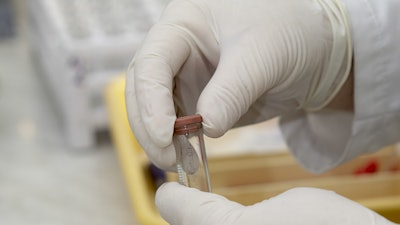
The Oregon Health Committee's new temporary rules for the state's legal marijuana program require testing for nearly 60 pesticides, including Fludioxonil, Spinosad and Propiconazole. The temporary rules also specify the action level ppm.
Per the rules, every batch (no larger than 10 lb. batches are permitted) "of usable marijuana prior to being sold or transferred to a consumer must be tested for the following:
(a) Pesticides
(b) Microbiological contaminants
(c) Water activity and moisture content
(d) THC and CBD concentration
Batches of usable marijuana intended for use by a processor to make a cannabinoid edibles, and cannabinoid concentrates and extracts also must be tested for pesticides, solvents, THC and CBD content.
The temporary regulations also specify requirements for testing processes, includin that usable marijuana may only be sampled after it is cured, and that the samples must represent a minimum of 0.5 percent of each batch.
For cannabinoid concentrates, extracts and products, samples must be taken from random locations within each batch.
Standards for testing for microbiological contaminants require lab testing for E. coli and Salmonella, and sets levels for failure limits for E. coli at more than 100 colony forming units per gram, and for Salmonella at more than 0 colony forming units per gram.
Cannabinoid edibles must show that the cannabinoid edible batch is homogeneous, a challenge cited by many in the industry. According to the temporary regulations, "In order to be considered homogenous the samples from five consecutive process lots of the same product must not exceed a 30 percent relative percentage difference in THC.
For cannabinoid concentrates, extracts and cannabinoid products other than edibles, "At least 20 representative samples must be taken from random locations in a process lot to test for homogeneity." The samples must have "a relative standard deviation (RSD) of less than 20 percent."
What happens to samples that fail tests? The rules state that if a sample fails an initial test, "a licensee or registrant may:
(a) Instruct the lab that did the initial test to send a portion of the sample that failed to two other laboratories of the licensee’s or registrant’s choice, for retesting; or
(b) Have two other laboratories of the licensee’s or registrant’s choice resample and retest the new sample or samples.
If a sample passes retesting done by both the other laboratories, the sample is considered compliant with the rules."
Batch samples that fail tests for pesticides or solvents, or microbiological contaminants, must be "destroyed in a manner approved by the Oregon Health Authority, which must then report to the Oregon Department of Agriculture all failed test results. A representative of the Health Authority must witness the batch destruction or disposal.
An interesting regulation is that licensees may file a written request with the Health Authority to be exempt from the requirement that every batch be tested for pesticides, "if the licensee or registrant can demonstrate that none of the batches from any of the harvest lots tested in the last 12 months have failed a pesticide test."
Read the full temporary rules, which also include requirements for labeling and single-serving dosages, here.
The new rules will be effective Jan. 1, 2016, through June 28, 2016.



























